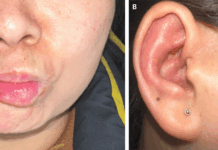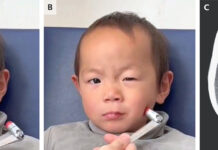
Fournier’s gangrene and intravenous drug abuse: an unusual case report
A 52-year-old male patient with a history of intravenous drug abuse presented to the emergency with Fournier’s gangrene. The patient was in methadone maintenance therapy and presented with fever, acute renal failure, anuria, poor hygienic conditions and necrotic tissue that involved the genitalia. The patient did not report of any other neurological symptoms at the time of admission.
The patient was negative for HIV and reported no other neurological symptoms at the time of admission. He had no major comorbidities, a Charlson Comorbidity Index Score of 2 and an Eastern Cooperative Oncology Group (ECOG) of 1.
An ultrasound examination of the scrotum was performed which showed hypoechoic area, augmented vascular sign, in addition to the right testis augmented in volume with altered echogenicity. The left testis was hypervascularised with hypoechoic area and irregular echogenicity. For further evaluation, a CT scan was performed. Findings of the CT were consistent with phlogosis and edema of the scrotum with unrecognisable right testis. In addition to this, inguinal bilateral and right external iliac lympadenopathy was evident with thickened skin, subcutaneous planes and spermatic cord.
The patient was diagnosed with Fournier’s gangrene. Fournier’s gangrene is a potentially fatal condition characterised by necrotising fasciitis of the external genital, perineal and perianal region.
Treatment plan
The patient was advised resuscitation intravenous fluid support and antibiotic therapy with tigecycline and meropenem. An extended surgical debridement of the external genital, perineal, peianal and infrapubic regions to healthy tissue was performed. Moreover, also underwent right orchiectomy.
Microbiologic culture of the wound specimen revealed Staphylococcus lugdunensis with susceptibility to triglyceride. However, urine and blood samples were negative. The patient was given tigecycline and meropenem until discharge. The anuric conditions persisted for 24 hours and then the patient developed polyuria with renal impairment, requiring treatment with dialysis.
The patient revealed injecting cocaine into the superficial dorsal vein of the penis 5 days after surgical debridement. Histology confirmed inflammatory necrotizing process of subcutaneous tissue, expanding to skin, testicular and epididymis parenchyma, rete testis and peritesticular tissue.
No other wound treatment were performed and the patient was discharged 14 days after the surgical debridement. A skin graft was performed a month later.
References
Fournier’s Gangrene and Intravenous Drug Abuse: an Unusual Case Report and Review of The Literature https://www.ncbi.nlm.nih.gov/pmc/articles/PMC6947763/



